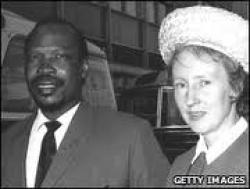
Published date
Seretse Khama succeeded his father, Kgosi (King) Khama III known as Khama the Good, ruler of the Bangwanto people. Subsequent to his father’s death Khama was considered the rightful heir to the Ngwato chieftaincy in Botswana (then known as Bechuanaland) and became a chief of the Bangwanto tribe. Seretse acquired his education in South Africa and he graduated from Fort Hare University College with a B.A. degree. Determined to further his studies in law he left for England. It is here that he first met his wife Ruth William. William was a WAAF ambulance driver during World War II and worked as a clerk at Lloyds in 1947. The two married in September 1948.
Their marriage was prohibited in Botswana and escalated into a political turmoil. This was in terms of the Prohibition of Mixed Marriages Act, Act No 55 of 1949 enacted by the apartheid government. The Act forbade marriages between Whites and other races; it was the case for Khama’s marriage.
Back at Khama’s home his furious uncle, Tshekedi ordered him to come home and was eager to prevent their marriage. To make matters worse Khama was on the verge of losing his chieftaincy. Upon his arrival he was able to persuade his people that he was eligible to carry on with the chieftaincy and they even approved of his marriage. The family recognized him as Kgosi (King) and Ruth, as his wife, was accepted and warmly welcomed. This was done at a meeting of Elders held by the Bangwanto people.
References
SAHO, President Seretse Khama, from South African History Online, [online], Available at www.sahistory.org.za [Accessed: 28 March 2014]|Evans, B.A., Sir Seretse Khama, from the African History, [online], Available at africanhistory.about.com [Accessed: 28 March 2014]